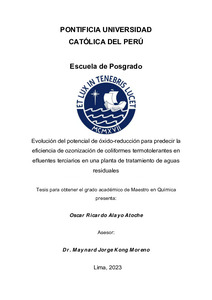El sistema se apagará debido a tareas habituales de mantenimiento. Por favor, guarde su trabajo y desconéctese.
Evolución del potencial de óxido-reducción para predecir la eficiencia de ozonización de coliformes termotolerantes en efluentes terciarios en una planta de tratamiento de aguas residuales
| dc.contributor.advisor | Kong Moreno, Maynard Jorge | |
| dc.contributor.author | Alayo Atoche, Oscar Ricardo | |
| dc.date.accessioned | 2024-02-06T14:28:16Z | |
| dc.date.available | 2024-02-06T14:28:16Z | |
| dc.date.created | 2023 | |
| dc.date.issued | 2024-02-06 | |
| dc.identifier.uri | http://hdl.handle.net/20.500.12404/27042 | |
| dc.description.abstract | En esta investigación se analiza la evolución del potencial de oxidación-reducción (ORP) y parámetros fisicoquímicos como oxígeno disuelto, pH, turbidez, sólidos disueltos totales, conductividad electrolítica, entre otros, con el fin de predecir la calidad de aguas residuales in situ, durante un proceso de desinfección con ozono, relacionándolos con parámetros microbiológicos como la demanda bioquímica de oxígeno (DBO), la demanda química de oxígeno (DQO), así como el contenido de coliformes totales y coliformes termotolerantes. Estos estudios se realizaron sobre efluentes terciarios de la planta de tratamiento de aguas residuales (PTAR) de SEDAPAL en Cieneguilla (Lima, Perú). Dentro de este proceso de ozonización, los resultados del ORP muestran un comportamiento particular frente al contenido de coliformes termotolerantes. Se propone un modelo matemático para correlacionar el ORP con el contenido de coliformes termotolerantes (actividad microbiana), logrando un enfoque semicuantitativo. Estas mediciones de ORP podrían utilizarse como indicador in situ para predecir la calidad de las aguas residuales tratadas con ozono. En condiciones de dosis de ozono de 13.33 mg/L y después de 30 minutos de ozonización, el ORP aumenta consistentemente por encima de 390 mV, logrando así valores aceptables para el contenido de coliformes termotolerantes dentro de los límites máximos permisibles (LMP) establecidos para efluentes en plantas de tratamiento de aguas residuales domésticas o municipales (según el Ministerio del Ambiente de Perú), incluso para muestras iniciales de hasta 5.400.000 NMP/100 mL de coliformes termotolerantes antes de que comience el proceso de desinfección. | es_ES |
| dc.description.abstract | In this research, the evolution of the oxidation-reduction potential (ORP) and physicochemical parameters such as dissolved oxygen, pH, turbidity, total dissolved solids, electrolytic conductivity, among others, is analyzed with the purpose of predicting the quality of wastewater in situ during a disinfection process with ozone, relating them to microbiological parameters such as biochemical oxygen demand (BOD), chemical oxygen demand (COD), as well as the content of total coliforms and thermotolerant coliforms. These studies were performed on tertiary effluents in the wastewater treatment plant (WWTP) of SEDAPAL in Cieneguilla (Lima, Peru). Within this ozonation process, the ORP results show a particular behavior against the content of thermotolerant coliforms. A mathematical model is proposed to correlate ORP with the content of thermotolerant coliforms (microbial activity), achieving a semiquantitative approach. These ORP measurements could be used as an in situ indicator to predict the quality of wastewater treated with ozone. At ozone dose conditions of 13.33 mg/L and after 30 minutes of ozonation, the ORP consistently rises above 390 mV, achieving thereby acceptable values for the content of thermotolerant coliforms within the maximum permissible limits (MPL) set for effluents of domestic or municipal wastewater treatment plants (according to the Ministry of Environment in Peru), even for initial samples as high as 5,400,000 NMP/100 mL of thermotolerant coliforms before the disinfection process begins. | es_ES |
| dc.language.iso | spa | es_ES |
| dc.publisher | Pontificia Universidad Católica del Perú | es_ES |
| dc.rights | info:eu-repo/semantics/embargoedAccess | es_ES |
| dc.rights.uri | http://creativecommons.org/licenses/by-nc-sa/2.5/pe/ | * |
| dc.subject | Aguas residuales--Tratamiento | es_ES |
| dc.subject | Ozono | es_ES |
| dc.subject | Química | es_ES |
| dc.title | Evolución del potencial de óxido-reducción para predecir la eficiencia de ozonización de coliformes termotolerantes en efluentes terciarios en una planta de tratamiento de aguas residuales | es_ES |
| dc.type | info:eu-repo/semantics/masterThesis | es_ES |
| thesis.degree.name | Maestro en Química | es_ES |
| thesis.degree.level | Maestría | es_ES |
| thesis.degree.grantor | Pontificia Universidad Católica del Perú. Escuela de Posgrado | es_ES |
| thesis.degree.discipline | Química | es_ES |
| renati.advisor.dni | 06391106 | |
| renati.advisor.orcid | https://orcid.org/0000-0001-5789-3063 | es_ES |
| renati.author.dni | 10691849 | |
| renati.discipline | 531057 | es_ES |
| renati.juror | Guzman Cordova, Maribel Giovana | es_ES |
| renati.juror | Kong Moreno, Maynard Jorge | es_ES |
| renati.juror | Obregon Valencia, Daniel Cristopher | es_ES |
| renati.level | https://purl.org/pe-repo/renati/level#maestro | es_ES |
| renati.type | https://purl.org/pe-repo/renati/type#tesis | es_ES |
| dc.date.EmbargoEnd | 2024-07-01 | |
| dc.publisher.country | PE | es_ES |
| dc.subject.ocde | https://purl.org/pe-repo/ocde/ford#1.04.00 | es_ES |







